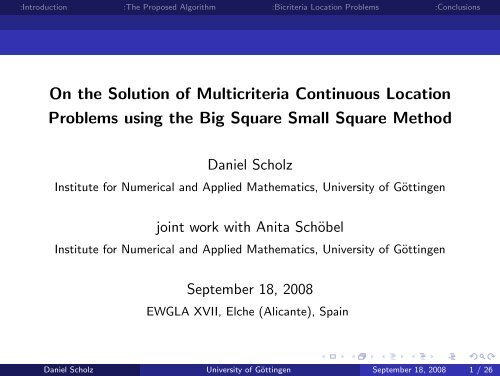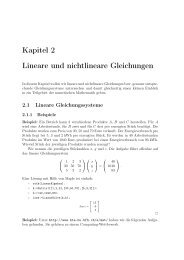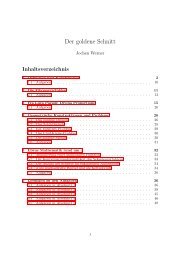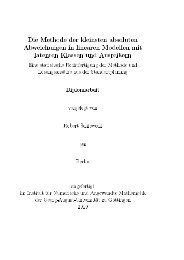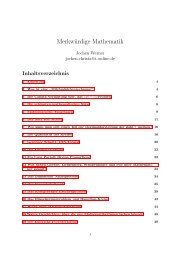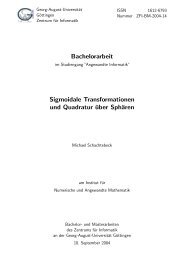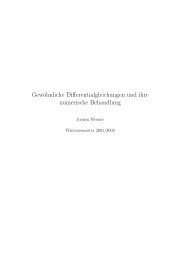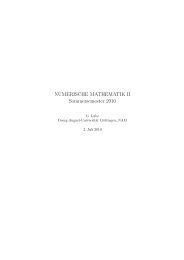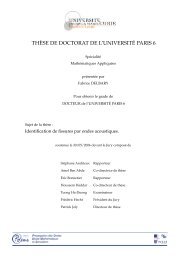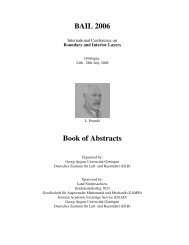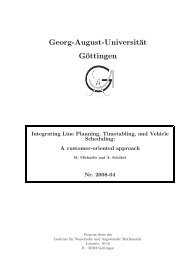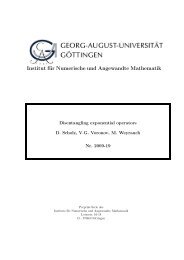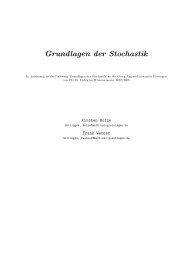University of Göttingen
University of Göttingen
University of Göttingen
You also want an ePaper? Increase the reach of your titles
YUMPU automatically turns print PDFs into web optimized ePapers that Google loves.
:Introduction :The Proposed Algorithm :Bicriteria Location Problems :Conclusions<br />
On the Solution <strong>of</strong> Multicriteria Continuous Location<br />
Problems using the Big Square Small Square Method<br />
Daniel Scholz<br />
Institute for Numerical and Applied Mathematics, <strong>University</strong> <strong>of</strong> <strong>Göttingen</strong><br />
joint work with Anita Schöbel<br />
Institute for Numerical and Applied Mathematics, <strong>University</strong> <strong>of</strong> <strong>Göttingen</strong><br />
September 18, 2008<br />
EWGLA XVII, Elche (Alicante), Spain<br />
Daniel Scholz <strong>University</strong> <strong>of</strong> <strong>Göttingen</strong> September 18, 2008 1 / 26
:Introduction :The Proposed Algorithm :Bicriteria Location Problems :Conclusions<br />
Outline<br />
1. Introduction<br />
1.1 Motivation<br />
1.2 Definitions and Notations<br />
1.3 Epsilon Efficency<br />
2. The proposed Algorithm<br />
2.1 The BSSS Method<br />
2.2 Our Algorithm<br />
2.3 The Output Set<br />
3. Bicriteria Location Problems<br />
3.1 Semi-Obnoxious Problem<br />
3.2 Minimax and Maximin<br />
3.3 Numerical Results<br />
4. Conclusions<br />
4.1 Extensions<br />
4.2 References<br />
Daniel Scholz <strong>University</strong> <strong>of</strong> <strong>Göttingen</strong> September 18, 2008 2 / 26
:Introduction :The Proposed Algorithm :Bicriteria Location Problems :Conclusions<br />
:Motivation :Definitions and Notations :Epsilon Efficency<br />
A Semi-obnoxious Location Problem<br />
Figure: Where to locate a new waste dump?<br />
Daniel Scholz <strong>University</strong> <strong>of</strong> <strong>Göttingen</strong> September 18, 2008 3 / 26
:Introduction :The Proposed Algorithm :Bicriteria Location Problems :Conclusions<br />
:Motivation :Definitions and Notations :Epsilon Efficency<br />
A Semi-obnoxious Location Problem<br />
Figure: Where to locate a new waste dump?<br />
Daniel Scholz <strong>University</strong> <strong>of</strong> <strong>Göttingen</strong> September 18, 2008 3 / 26
:Introduction :The Proposed Algorithm :Bicriteria Location Problems :Conclusions<br />
:Motivation :Definitions and Notations :Epsilon Efficency<br />
A Semi-obnoxious Location Problem<br />
Figure: Where to locate a new waste dump?<br />
Daniel Scholz <strong>University</strong> <strong>of</strong> <strong>Göttingen</strong> September 18, 2008 3 / 26
:Introduction :The Proposed Algorithm :Bicriteria Location Problems :Conclusions<br />
:Motivation :Definitions and Notations :Epsilon Efficency<br />
Notations<br />
Notation 1<br />
A multicriteria optimization problem can be formulated as<br />
vec min<br />
x∈X f (x) = (f1(x), . . . , fp(x)),<br />
where X ⊂ R n and fi(x) : R n → R. Define Y := f (X ) ⊂ R p .<br />
Notation 2<br />
Let x = (x1, . . . , xp) and y = (y1, . . . , yp) be two vectors in R p .<br />
1. We write x ≦ y if and only if xi ≤ yi for i = 1, . . . , p.<br />
2. We write x ≤ y if and only if xi ≤ yi for i = 1, . . . , p and x �= y.<br />
3. We write x < y if and only if xi < yi for i = 1, . . . , p.<br />
Define R p<br />
≥ := {x ∈ Rp : x ≥ 0}.<br />
Daniel Scholz <strong>University</strong> <strong>of</strong> <strong>Göttingen</strong> September 18, 2008 4 / 26
:Introduction :The Proposed Algorithm :Bicriteria Location Problems :Conclusions<br />
:Motivation :Definitions and Notations :Epsilon Efficency<br />
Efficient Solutions<br />
Definition 1 (Ehrgott 2000)<br />
A solution y ∈ X is called efficient if there is no x ∈ X satisfying<br />
f (x) ≤ f (y).<br />
Denote by XE ⊂ X the set <strong>of</strong> all efficient solutions and YN = f (XE ).<br />
Daniel Scholz <strong>University</strong> <strong>of</strong> <strong>Göttingen</strong> September 18, 2008 5 / 26
:Introduction :The Proposed Algorithm :Bicriteria Location Problems :Conclusions<br />
:Motivation :Definitions and Notations :Epsilon Efficency<br />
ε-efficient Solutions<br />
Definition 2 (Loridan 1984; White 1986)<br />
A solution y ∈ X is called ε-efficient, ε ∈ R p >, if there is no x ∈ X<br />
satisfying<br />
f (x) + ε ≤ f (y).<br />
Denote by X ε E the set <strong>of</strong> all ε-efficient solutions and Y ε N = f (X ε E ).<br />
Daniel Scholz <strong>University</strong> <strong>of</strong> <strong>Göttingen</strong> September 18, 2008 6 / 26
:Introduction :The Proposed Algorithm :Bicriteria Location Problems :Conclusions<br />
:Motivation :Definitions and Notations :Epsilon Efficency<br />
The Definition <strong>of</strong> ε-efficient Solutions<br />
Figure: For the definition <strong>of</strong> ε-efficient solutions.<br />
Daniel Scholz <strong>University</strong> <strong>of</strong> <strong>Göttingen</strong> September 18, 2008 7 / 26
:Introduction :The Proposed Algorithm :Bicriteria Location Problems :Conclusions<br />
:The BSSS Method :The Multicriteria BSSS Method :The Output Set<br />
The General Idea <strong>of</strong> the BSSS Method<br />
Figure: The general idea <strong>of</strong> the BSSS algorithm.<br />
Daniel Scholz <strong>University</strong> <strong>of</strong> <strong>Göttingen</strong> September 18, 2008 8 / 26
:Introduction :The Proposed Algorithm :Bicriteria Location Problems :Conclusions<br />
:The BSSS Method :The Multicriteria BSSS Method :The Output Set<br />
The General Idea <strong>of</strong> the BSSS Method<br />
Figure: The general idea <strong>of</strong> the BSSS algorithm.<br />
Daniel Scholz <strong>University</strong> <strong>of</strong> <strong>Göttingen</strong> September 18, 2008 8 / 26
:Introduction :The Proposed Algorithm :Bicriteria Location Problems :Conclusions<br />
:The BSSS Method :The Multicriteria BSSS Method :The Output Set<br />
The General Idea <strong>of</strong> the BSSS Method<br />
Figure: The general idea <strong>of</strong> the BSSS algorithm.<br />
Daniel Scholz <strong>University</strong> <strong>of</strong> <strong>Göttingen</strong> September 18, 2008 8 / 26
:Introduction :The Proposed Algorithm :Bicriteria Location Problems :Conclusions<br />
:The BSSS Method :The Multicriteria BSSS Method :The Output Set<br />
The General Idea <strong>of</strong> the BSSS Method<br />
Figure: The general idea <strong>of</strong> the BSSS algorithm.<br />
Daniel Scholz <strong>University</strong> <strong>of</strong> <strong>Göttingen</strong> September 18, 2008 8 / 26
:Introduction :The Proposed Algorithm :Bicriteria Location Problems :Conclusions<br />
:The BSSS Method :The Multicriteria BSSS Method :The Output Set<br />
The General Idea <strong>of</strong> the BSSS Method<br />
Figure: The general idea <strong>of</strong> the BSSS algorithm.<br />
Daniel Scholz <strong>University</strong> <strong>of</strong> <strong>Göttingen</strong> September 18, 2008 8 / 26
:Introduction :The Proposed Algorithm :Bicriteria Location Problems :Conclusions<br />
:The BSSS Method :The Multicriteria BSSS Method :The Output Set<br />
The General Idea <strong>of</strong> the BSSS Method<br />
Figure: The general idea <strong>of</strong> the BSSS algorithm.<br />
Daniel Scholz <strong>University</strong> <strong>of</strong> <strong>Göttingen</strong> September 18, 2008 8 / 26
:Introduction :The Proposed Algorithm :Bicriteria Location Problems :Conclusions<br />
:The BSSS Method :The Multicriteria BSSS Method :The Output Set<br />
The General Idea Multicriteria BSSS Method<br />
Figure: The general idea <strong>of</strong> the multicriteria BSSS algorithm.<br />
Daniel Scholz <strong>University</strong> <strong>of</strong> <strong>Göttingen</strong> September 18, 2008 9 / 26
:Introduction :The Proposed Algorithm :Bicriteria Location Problems :Conclusions<br />
:The BSSS Method :The Multicriteria BSSS Method :The Output Set<br />
The General Idea Multicriteria BSSS Method<br />
Figure: The general idea <strong>of</strong> the multicriteria BSSS algorithm.<br />
Daniel Scholz <strong>University</strong> <strong>of</strong> <strong>Göttingen</strong> September 18, 2008 9 / 26
:Introduction :The Proposed Algorithm :Bicriteria Location Problems :Conclusions<br />
:The BSSS Method :The Multicriteria BSSS Method :The Output Set<br />
The General Idea Multicriteria BSSS Method<br />
Figure: The general idea <strong>of</strong> the multicriteria BSSS algorithm.<br />
Daniel Scholz <strong>University</strong> <strong>of</strong> <strong>Göttingen</strong> September 18, 2008 9 / 26
:Introduction :The Proposed Algorithm :Bicriteria Location Problems :Conclusions<br />
:The BSSS Method :The Multicriteria BSSS Method :The Output Set<br />
The General Idea Multicriteria BSSS Method<br />
Figure: The general idea <strong>of</strong> the multicriteria BSSS algorithm.<br />
Daniel Scholz <strong>University</strong> <strong>of</strong> <strong>Göttingen</strong> September 18, 2008 9 / 26
:Introduction :The Proposed Algorithm :Bicriteria Location Problems :Conclusions<br />
:The BSSS Method :The Multicriteria BSSS Method :The Output Set<br />
The General Idea Multicriteria BSSS Method<br />
Figure: The general idea <strong>of</strong> the multicriteria BSSS algorithm.<br />
Daniel Scholz <strong>University</strong> <strong>of</strong> <strong>Göttingen</strong> September 18, 2008 9 / 26
:Introduction :The Proposed Algorithm :Bicriteria Location Problems :Conclusions<br />
:The BSSS Method :The Multicriteria BSSS Method :The Output Set<br />
The Big Square Small Square Method for Multicriteria Optimization<br />
Daniel Scholz <strong>University</strong> <strong>of</strong> <strong>Göttingen</strong> September 18, 2008 10 / 26
:Introduction :The Proposed Algorithm :Bicriteria Location Problems :Conclusions<br />
:The BSSS Method :The Multicriteria BSSS Method :The Output Set<br />
Properties <strong>of</strong> the Output Set (1)<br />
Figure: All efficient solutions are contained in the output set.<br />
Daniel Scholz <strong>University</strong> <strong>of</strong> <strong>Göttingen</strong> September 18, 2008 11 / 26
:Introduction :The Proposed Algorithm :Bicriteria Location Problems :Conclusions<br />
:The BSSS Method :The Multicriteria BSSS Method :The Output Set<br />
Properties <strong>of</strong> the Output Set (2)<br />
Figure: All points in the output set are ε-efficient solutions.<br />
Daniel Scholz <strong>University</strong> <strong>of</strong> <strong>Göttingen</strong> September 18, 2008 12 / 26
:Introduction :The Proposed Algorithm :Bicriteria Location Problems :Conclusions<br />
:Semi-Obnoxious Location Problem :Maximin and Minimax Problem :Numerical Results<br />
A Semi-Obnoxious Location Problem<br />
Consider n existing locations ak = (ak,1, ak,2) on the plane with positive<br />
weights wk, vk > 0 for k = 1, . . . , n. We want to find one new facility<br />
x = (x1, x2) with respect to the following criteria.<br />
Minimize the sum <strong>of</strong> service costs from the locations to the new facility:<br />
min<br />
x∈X f1(x) =<br />
n�<br />
wk · d(ak, x).<br />
k=1<br />
Minimize the sum <strong>of</strong> the reciprocal squared distance from the locations to<br />
the new facility:<br />
min<br />
x∈X f2(x)<br />
n� vk<br />
=<br />
.<br />
d(ak, x) 2<br />
k=1<br />
See Brimberg and Juel (1998) and Skriver and Anderson (2003).<br />
Daniel Scholz <strong>University</strong> <strong>of</strong> <strong>Göttingen</strong> September 18, 2008 13 / 26
:Introduction :The Proposed Algorithm :Bicriteria Location Problems :Conclusions<br />
:Semi-Obnoxious Location Problem :Maximin and Minimax Problem :Numerical Results<br />
Example <strong>of</strong> a Semi-Obnoxius Location Problem (1)<br />
We adopted the input data from Brimberg and Juel (1998).<br />
For ε = (ε1, ε2) we chose<br />
k a 1 k a 2 k wk vk<br />
1 0.20 0.80 5.0 1.0<br />
2 0.72 0.32 7.0 1.0<br />
3 0.88 0.64 2.0 1.0<br />
4 0.56 0.68 3.0 1.0<br />
5 0.28 0.08 6.0 1.0<br />
6 0.20 0.60 1.0 1.0<br />
7 0.48 0.16 5.0 1.0<br />
Table: The input data for the example instance.<br />
ε1 = 0.02 · (f1(x ∗ 2 ) − f1(x ∗ 1 )) and ε2 = 0.02 · (f2(x ∗ 1 ) − f2(x ∗ 2 )).<br />
Daniel Scholz <strong>University</strong> <strong>of</strong> <strong>Göttingen</strong> September 18, 2008 14 / 26
:Introduction :The Proposed Algorithm :Bicriteria Location Problems :Conclusions<br />
:Semi-Obnoxious Location Problem :Maximin and Minimax Problem :Numerical Results<br />
Example <strong>of</strong> a Semi-Obnoxius Location Problem (2)<br />
Daniel Scholz <strong>University</strong> <strong>of</strong> <strong>Göttingen</strong> September 18, 2008 15 / 26
:Introduction :The Proposed Algorithm :Bicriteria Location Problems :Conclusions<br />
:Semi-Obnoxious Location Problem :Maximin and Minimax Problem :Numerical Results<br />
The Bicriteria Maximin and Minimax Problem<br />
Minimize the distance from the new facility to the furthest location:<br />
min<br />
x∈X f1(x) = max<br />
k=1,...,n wk · d(ak, x).<br />
Maximize the distance between the new facility and the nearest resident:<br />
Therefore, the bicriteria problem is<br />
max<br />
x∈X f2(x) = min<br />
k=1,...,n vk · d(ak, x).<br />
vec min<br />
x∈X (f1(x), −f2(x)).<br />
See Ohsawa (2000) and Ohsawa and Tamura (2003).<br />
Daniel Scholz <strong>University</strong> <strong>of</strong> <strong>Göttingen</strong> September 18, 2008 16 / 26
:Introduction :The Proposed Algorithm :Bicriteria Location Problems :Conclusions<br />
:Semi-Obnoxious Location Problem :Maximin and Minimax Problem :Numerical Results<br />
Example for the Bicriteria Maximin and Minimax Problem<br />
Daniel Scholz <strong>University</strong> <strong>of</strong> <strong>Göttingen</strong> September 18, 2008 17 / 26
:Introduction :The Proposed Algorithm :Bicriteria Location Problems :Conclusions<br />
:Semi-Obnoxious Location Problem :Maximin and Minimax Problem :Numerical Results<br />
Computational Results for the Semi-Obnoxious Location Problem<br />
Technical Information<br />
Implemented in JAVA, using double precision arithmetic, run on a 1.3 GHz<br />
computer.<br />
Input Data<br />
We generated 10 ≤ n ≤ 10, 000 existing locations randomly in [0, 1] 2 and<br />
weights randomly in [0, 1].<br />
Ten problems were run for various values <strong>of</strong> n for every problem.<br />
For ε = (ε1, ε2) we chose<br />
ε1 = 0.05 · (f1(x ∗ 2 ) − f1(x ∗ 1 )) and ε2 = 0.05 · (f2(x ∗ 1 ) − f2(x ∗ 2 ))<br />
throughout all problems.<br />
Daniel Scholz <strong>University</strong> <strong>of</strong> <strong>Göttingen</strong> September 18, 2008 18 / 26
:Introduction :The Proposed Algorithm :Bicriteria Location Problems :Conclusions<br />
:Semi-Obnoxious Location Problem :Maximin and Minimax Problem :Numerical Results<br />
Computational Results for the Semi-Obnoxious Location Problem<br />
Run time (sec.) Iterations<br />
n Min Max Ave. Min Max Ave.<br />
10 0.02 0.85 0.33 442 2,238 1,374.8<br />
20 0.10 3.64 1.02 870 3,494 1,925.7<br />
50 0.32 17.82 3.92 1,371 7,798 3,345.6<br />
100 0.63 22.30 6.07 1,914 7,880 4,246.8<br />
200 0.77 29.53 9.59 1,289 10,166 5,370.7<br />
500 1.61 51.23 14.74 1,818 11,850 5,741.3<br />
1, 000 8.96 41.26 22.26 3,954 10,804 7,409.9<br />
2, 000 31.47 54.77 42.91 7,703 11,591 9,450.3<br />
5, 000 98.23 198.13 155.86 10,654 17,593 15,054.1<br />
10, 000 252.34 456.46 339.15 14,280 20,198 17,680.5<br />
Table: Results for the semi-obnoxious location problem for 10 runs using random<br />
input.<br />
Daniel Scholz <strong>University</strong> <strong>of</strong> <strong>Göttingen</strong> September 18, 2008 19 / 26
:Introduction :The Proposed Algorithm :Bicriteria Location Problems :Conclusions<br />
:Semi-Obnoxious Location Problem :Maximin and Minimax Problem :Numerical Results<br />
Computational Results for the Maximin and Minimax Problem<br />
Run time (sec.) Iterations<br />
n Min Max Ave. Min Max Ave.<br />
10 0.03 0.22 0.10 450 1,082 797.6<br />
20 0.07 1.52 0.61 517 2,665 1,428.6<br />
50 0.07 3.94 1.48 511 4,271 2,365.9<br />
100 0.11 2.59 1.43 663 4,090 2,705.7<br />
200 0.49 8.66 2.52 1,459 4,976 3,037.3<br />
500 2.76 37.60 11.91 2,956 11,674 6,049.5<br />
1, 000 9.43 36.93 18.39 4,450 10,493 6,769.3<br />
2, 000 12.48 36.97 27.00 3,374 8,822 6,702.0<br />
5, 000 83.09 134.84 105.41 8,938 13,445 11,094.2<br />
10, 000 189.68 373.32 266.95 12,196 20,818 15,839.5<br />
Table: Results for the maximin and minimax location problem for 10 runs using<br />
random input.<br />
Daniel Scholz <strong>University</strong> <strong>of</strong> <strong>Göttingen</strong> September 18, 2008 20 / 26
:Introduction :The Proposed Algorithm :Bicriteria Location Problems :Conclusions<br />
:Extensions :References<br />
Further Ideas<br />
Some Extensions and Further Ideas<br />
1. The method is also applicable for objectives with more than two<br />
variables with just slightly changes.<br />
2. Approximating all ε-efficient solutions.<br />
3. Combining the BSSS approach with other multicriteria scalarization<br />
method, e.g. the ε-constrained method.<br />
Daniel Scholz <strong>University</strong> <strong>of</strong> <strong>Göttingen</strong> September 18, 2008 21 / 26
:Introduction :The Proposed Algorithm :Bicriteria Location Problems :Conclusions<br />
:Extensions :References<br />
Thank you!<br />
Daniel Scholz <strong>University</strong> <strong>of</strong> <strong>Göttingen</strong> September 18, 2008 22 / 26
:Introduction :The Proposed Algorithm :Bicriteria Location Problems :Conclusions<br />
:Extensions :References<br />
References<br />
Daniel Scholz <strong>University</strong> <strong>of</strong> <strong>Göttingen</strong> September 18, 2008 23 / 26
:Introduction :The Proposed Algorithm :Bicriteria Location Problems :Conclusions<br />
:Extensions :References<br />
References (1)<br />
J. Brimberg, H. Juel. (1998):<br />
A bicriteria model for locating a semi-desirable facility in the plane.<br />
European Journal <strong>of</strong> Operational Research, 106: 144–151.<br />
Z. Drezner, A. Suzuki (2004):<br />
The Big Trinangle Small Triangle Method for the Solution <strong>of</strong> Nonconvex<br />
Facility Location Problems.<br />
Operations Research, 52: 128–135.<br />
M. Ehrgott (2000):<br />
Multicriteria optimization.<br />
Springer Verlag, Berlin, 1st edition.<br />
H.W. Hamacher, S. Nickel (1996):<br />
Multicriteria planar location problems.<br />
European Journal <strong>of</strong> Operational Research, 94: 66–86.<br />
Daniel Scholz <strong>University</strong> <strong>of</strong> <strong>Göttingen</strong> September 18, 2008 24 / 26
:Introduction :The Proposed Algorithm :Bicriteria Location Problems :Conclusions<br />
:Extensions :References<br />
References (2)<br />
P. Hansen, D. Peeters, D. Richard, J.F. Thisse (1985):<br />
The Minisum and Minimax Location Problems Revisited.<br />
Operations Research, 33: 1251–1265.<br />
K. Ichida, Y. Fujii (1990):<br />
Multicriterion Optimization Using Interval Analysis.<br />
Computing, 44: 47–57.<br />
P. Loridan (1984):<br />
ε-Solutions in Vector Minimizatin Problems.<br />
Journal <strong>of</strong> Optimization Theory and Applications, 43: 265–276.<br />
Y. Ohsawa (2000):<br />
Bicriteria Euclidean Location Associated with Maximin and Minimax Criteria.<br />
Naval Research Logistics, 47: 581–592.<br />
Daniel Scholz <strong>University</strong> <strong>of</strong> <strong>Göttingen</strong> September 18, 2008 25 / 26
:Introduction :The Proposed Algorithm :Bicriteria Location Problems :Conclusions<br />
:Extensions :References<br />
References (3)<br />
Y. Ohsawa, K. Tamura (2003):<br />
Efficient Location for a Semi-Obnoxious Facility.<br />
Annals <strong>of</strong> Operations Research, 123: 173–188.<br />
F. Plastria (1992):<br />
GBSSS: The generalized big square small square method for planar<br />
single-facility location.<br />
European Journal <strong>of</strong> Operational Research, 62: 163–174.<br />
A.J.V. Skriver and K.A. Anderson (2003):<br />
The bicriterion semi-obnoxious location (BSL) problem solved by an<br />
ε-approximation.<br />
European Journal <strong>of</strong> Operational Research, 146: 517–528.<br />
D.J. White (1986):<br />
Epsilon Efficiency.<br />
Journal <strong>of</strong> Optimization Theory and Applications, 49: 319–337.<br />
Daniel Scholz <strong>University</strong> <strong>of</strong> <strong>Göttingen</strong> September 18, 2008 26 / 26


